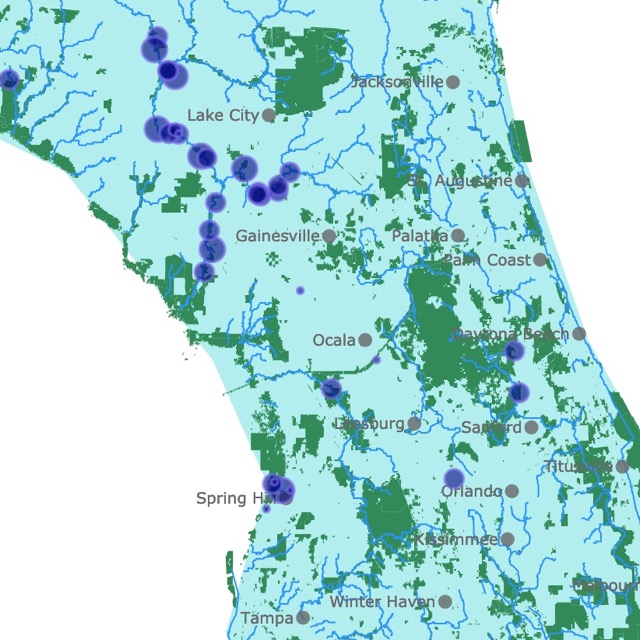Map of Warm Water Coral Reef Types
This interactive map shows the locations of different types of coral reefs around the world. Shallow bottom waters (above 200m) are represented with white. Blue color represents waters with more than 200m depth. Other colors represent different types of Coral Reefs. For more detail zoom in. For more data hover over the map. For more information scroll down.
What is a Coral?
Corals are small immobile animals related to jellyfish.
Their main structure is a polyp. Polyps have tentacles that can catch tiny organisms to feed
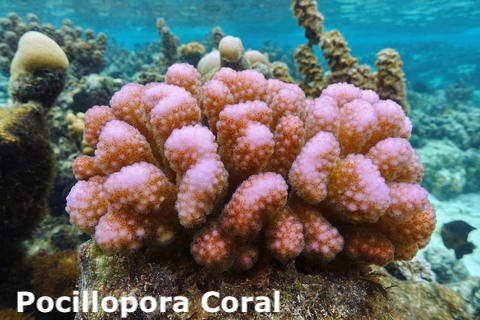
The hard skeleton of corals is the result of polyps absorbing calcium carbonate from the ocean and solidifying it into a rigid structure for support.
If you look at a coral, only a thin layer on top is alive. The rest is the skeleton, which may be decades old.
Shallow-water corals that live on warm waters (like those shown on this map) have another food source. They have zooxanthellae, which are single-celled algae. These algae produce food through photosynthesis.

The animal part of corals provides nutrients and a home to the algae. The algae provide food to its host. These algae provide some of the colors you see on corals.
The relationship between corals and their zooxanthellae is one of many examples of symbiosis, where different species live together and help each other.
Polyps are very small, about 1 inch in diameter, but because these are colonial animals, they form much larger sizes.
What is a Coral Reef?
Coral Reefs are ecosystems composed of hard skeletal structures of colonial marine invertebrates called Corals.
Coral Reefs are made of many colonies. The largest one is the Great Barrier Reef. This is such a large reef it is visible from space.
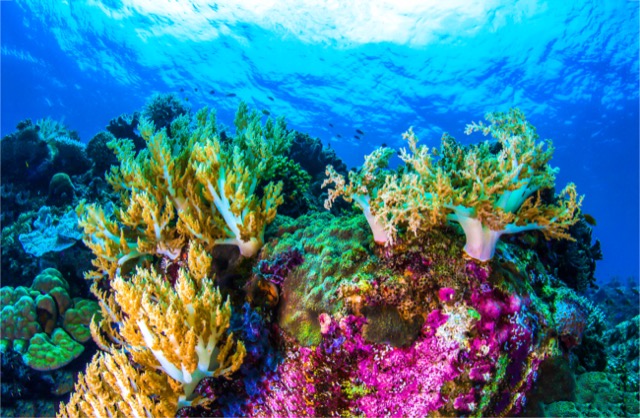
Corals take a long time to grow. Most grow less than an inch per year. Reefs themselves grow even more slowly. Individual colonies can often live decades to centuries.
We know the age of corals because they lay an annual ring just like trees do. These rings can also tell us the environmental conditions in which the coral lived decades ago.
The Great Barrier Reef, as it exists today, began growing about 20,000 years ago. Source: Smithsonian.
Types of Corals
Not all corals on the reef are stony corals. Corals have an incredible array of shapes and colors. In fact, there are hundreds of different species of corals.
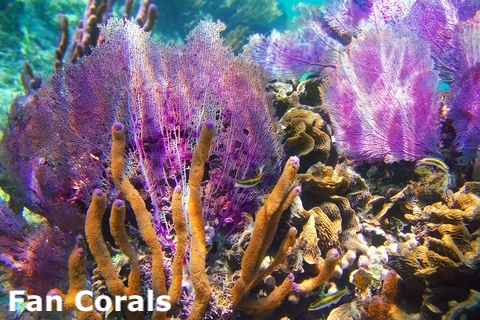
Each species is adapted to different environments and food resources. But without getting into details, they can be classified into 3 major kinds.
- Hydrocorals or Fire corals: These are reef-building corals with hard skeletons. They may cause a burning sensation when touched.
- Octocorals or Soft corals: These include sea fans and sea whips. They grow more like plants and don't have a skeletal structure.
- Antipatharians or Black corals: Another type of branching soft coral.
Coral Reef Habitats and Locations
Coral reefs cover less than 1% of the ocean floor. The following are some of the reasons they don't occupy a larger area of the sea floor.
Corals are found across the ocean in both shallow and deep waters. Reef-building corals are only found in tropical and subtropical waters. That means they grow 30 degrees North and -30 degrees South of the Equator, as shown in this map.
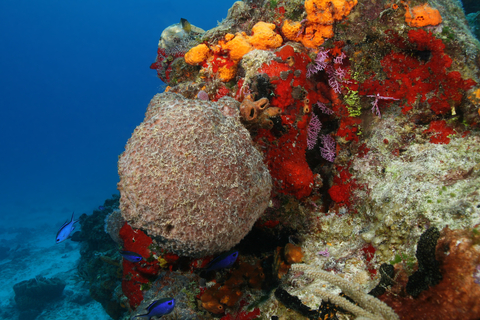
The reason coral reefs stay in these latitudes is because the algae found in their tissues need more light for photosynthesis, and they prefer water temperatures between 70-85°F (22-29°C).
Moreover, coral reefs are found in shallow waters with a maximum depth of 150m (492 feet) depth. This is because sunlight for photosynthesis does not penetrate further into the water column.
Clear waters also mean that areas close to river mouths do not promote coral reef growth. Silt and sediment block the sunlight for photosynthesis.
As seen on the map, Coral Reefs are almost absent on the East Coasts of Africa and the Americas.
This is due to upwelling and strong cold currents. Also, because the continental shelf of the Western Coast of South America is steep, therefore there is a there is a narrow, shallow area for the corals to thrive.
There are deep-sea corals that thrive in cold, dark water at depths of up to 20,000 feet (6,000 m). Both stony corals and soft corals can be found in the deep sea.
These corals do not have the same algae and do not need sunlight or warm water to survive. As mentioned before, they do not form reefs and are not included in this map.
Coral Reef Types
Reefs form when corals grow in shallow waters close to the shore of continents or smaller islands.
The location varies, but similar features help us classify coral reefs into 4 main categories. These categories are depicted with different colors on the map.
This is a large dataset, and not all reefs have been classified. Therefore not all of them have a category.
The categories are Fringing Reef, Barrier Reef, Atoll Reef, and Patch Reef. They are described below.
Fringing Reefs
Most coral reefs are called fringe reefs because they fringe the coastline of a nearby landmass.
These land masses may be islands or continents. They are separated from the shore by narrow, shallow lagoons.
Fringing reefs are the most common type of reef.
Barrier Reefs
These coral reefs are also parallel to the coastline but are separated by deeper, wider lagoons.
At their shallowest point, they can reach the water’s surface forming a “barrier” to navigation.
The Great Barrier Reef in Australia is the world's largest and most famous barrier reef.

Patch Reef
Patch reefs typically "are small, isolated reefs that grow up from the open bottom of an island platform or continental shelf.
They usually occur between fringing reefs and barrier reefs.
They vary significantly in size and rarely reach the surface of the water. Source: Coral.org.
Atoll Reef
Atoll Reefs occur when a volcano gradually sinks after millions of years.
The Corals keep growing on top of each other and sideways.
Over time a lagoon forms between the volcanic island and the corals. This results in a barrier reef.
When the volcano is completely submerged, and only a ring of corals remains. This is called an Atoll.
The force of the waves will eventually form sand that will pile on the atoll creating land. Many of the Marshall Islands in the Pacific Ocean are atolls.
Largest Coral Reefs
After the Great Barrier Reef, many claim to be the second largest. Some by area, some by length, some by miles, others in kilometers.
The numbers vary with the author and method. Other reefs could make the list, but the data is inconsistent. Here are the numbers by length.
| Reef | Countries | Length |
| Great Barrier Reef | Australia | 1,429 mi 2,299 km |
| Red Sea Coral Reef | Yemen, Saudi Arabia, Jordan, Djibouti, Eritrea, Sudan, Egypt, and Israel | 1,398 mi 2,250 km |
| New Caledonia Barrier Reef | New Caledonia | 994 mi 1,600 km |
| The Mesoamerican Barrier Reef | Mexico, Belize, Guatemala, and Honduras | 625 mi 1,005 km |
| Florida Reef System | USA | 358 mi 576 km |
| Adros Barrier Reef | Bahamas | 190 mi 305 km |
The Great Barrier Reef
The Great Barrier Reef is one of the most complex natural ecosystems in the world.
It extends from shallow estuarine areas to deep oceanic waters, with an average depth of 35 meters in its inshore waters.
The Reef includes 600 types of soft and hard corals, more than 100 species of jellyfish, 3,000 varieties of mollusks, 500 species of worms, 1,625 types of fish, 133 varieties of sharks and rays, and more than 30 species of whales and dolphins. Source: Barrier Reef.
The reef’s health has been declining. The reef coverage decreased by 50% between 1985 and 2012 due to damage caused by climate change, coral bleaching, invasive species such as crown-of-thorns starfish, and tropical cyclones.
You can find a package from Expedia that includes flights from L.A. to Queensland, Australia. It will also include a resort with easy access to the reef. For prices and dates, visit this link!
Red Sea Coral Reef
The Red Sea Coral Reef is a biodiversity hotspot with a high degree of endemism. (Endemism is the state of a species being found in a single defined geographic location).
The Red Sea has a broad latitudinal temperature gradient, ranging from a maximum of 28°C in the northern tip of the Gulf of Aqaba to a maximum of 34°C in the Dahlak Archipelago in the south.
This gradient is currently used to assess the effect of climate change on coral reefs. Source: Science, Diplomacy, and the Red Sea’s Unique Coral Reef: It’s Time for Action in Frontiers in Marine Science.
You can spend unforgettable days in a Red Sea resort in Egypt. Expedia has different options for you to choose from. For amenities and dates, go here!
New Caledonia Reef
New Caledonia Reef is a French territory located 1,200 kilometers (746 miles) east of Australia. This territory is home to the world's second-largest marine park.
New Caledonia's quarter of a million people depend on healthy ecosystems for their fresh water, food, and livelihoods, given that this is an island territory. Source: Conservation.org
Mesoamerican Barrier Reef
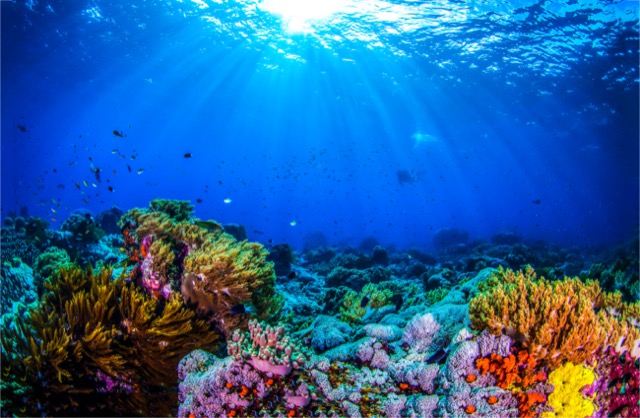
The Mesoamerican Barrier Reef next to the Yucatan Peninsula is the largest in the western hemisphere.
It boasts various types of coral reefs, numerous sand cays and mangrove islands, a rich mosaic of beaches, dunes, coastal wetlands, lagoons, mangrove forests, seagrass beds, and incredible seascapes such as the famous “Blue Hole”.
This reef is home to 500 fish species, 60 coral species, 350 mollusks and marine mammals, algae, and seagrasses.
The Mesoamerican Barrier Reef is also home to critically endangered species like the Hawksbill Turtle, saltwater crocodile, the largest population of manatees in the western Caribbean, and the largest aggregation of whale sharks in the world. Source Nature.org.
Yucatan has endless activities for visitors to enjoy. Expedia has hotels and resorts in Cancun with direct access to the Caribbean Sea. For amenities and prices, visit this link!
Florida's Coral Reef
Roughly two-thirds of Florida's Coral Reef lies within Biscayne National Park and the Florida Keys National Marine Sanctuary.
Florida's coral reef system most closely resembles a barrier reef; however, the reefs are closer to shore, and they lack the shallow coastal lagoons found on most barrier reefs.
This reef has more than 45 species of stony corals and 35 of octocorals. Each kind lives in a separate colony that is shaped differently.
Marine sponges are also essential within the coral reef community. With more than 70 species, they can be found along the Florida Reef Tract.
Historically, Florida's reef-building corals were brain, star, and elkhorn. Source: FDEP.
You can stay in various retreats in the Florida Keys, just steps away from the water. For details, go to VRBO!
Andros Barrier Reef
Andros, in the Bahamas, is home to a large variety of marine life, with over 164 species of fish and coral, making it one of the most popular locations in the country for divers and snorkelers.
It is also the only place in the world with more than one Nassau grouper aggregation.
This reef also has other sea creatures, such as marlins, sailfish, stingrays, reef sharks, lobsters, turtles, moray eels, octopi, and game fish. Source: the Culture trip.
With this comprehensive list, you probably have decided to get your feet wet and dive to one of these locations or at least snorkel to the closest one.
You can stay in a cabana with your own private beach in the Bahamas. VRBO has different options depending on your interests. For amenities and dates, click here!
Importance of Coral Reefs
Coral reefs provide a habitat for a large variety of marine life. Some organisms that depend on reefs include sponges, oysters, clams, crabs, sea stars, lobsters, sharks, worms, rays, sea urchins, and many fish species.
Coral Reefs are so diverse they have been coined "the rainforests of the sea".

They are so diverse and important that a healthy coral reef may provide a habitat, a feeding ground, spawning habitat, and a nursery ground for over a million aquatic species, including commercially harvested fish species.
Because they provide habitat to commercially harvested fish species, they are also the main food source for people living in tropical countries, especially those on small islands.
Coral Reefs are also a magnet for recreation and tourism opportunities, such as fishing, scuba diving, and snorkeling. These activities contribute billions of dollars to local economies.
The least known reason why corals are so important is that they protect coastal infrastructure and prevent loss of life from storms, tsunamis, floods, and erosion.
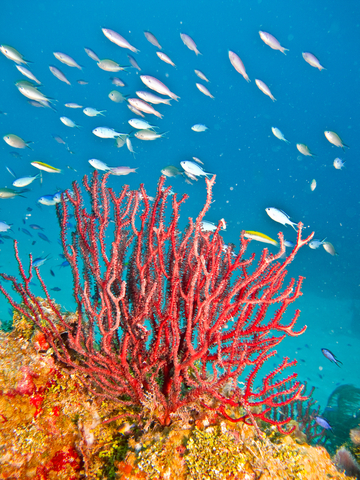
Small communities have always used corals for medicinal purposes. Still, more studies and resources have been recently used to research corals as new medicines and treatments for diseases.
These services can be translated into economic worth. By one estimate, the total worth per year of the world’s coral reefs is $29.8 billion.
In the United States, the National Marine Fisheries Service estimates the annual commercial value of U.S. fisheries from coral reefs alone to be over $100 million annually.
Reef-based recreational fisheries, also in the U.S., generate another $100 million annually, Source: EPA.
Coral Reef Threats
There are 3 main threats to coral reefs. They are all a result of human development.
Ocean Acidification
The first one is ocean acidification. Ocean acidification results from the excess use of fossil fuels, which results in elevated atmospheric carbon dioxide concentrations.

This carbon dioxide concentration is so high it gets absorbed by the ocean.
The absorption of CO2 decreases water pH and results in ocean acidification.
The increasing acidification of the ocean inhibits the coral's ability to retain the calcium carbonate for its exoskeleton.
Water Pollution
As the human population grows, crop fields and livestock have grown.
Both have increased the number of fertilizers and manure added to soils. When these nutrient-rich waters reach the ocean, it results in an excess growth of plants and algae that blocks the sunlight of Coral Reefs.
Water pollution also includes pesticides, gasoline, and oil that will kill or damage the corals.
Due to human development and presence, there is also silt and sediment from eroded landscapes. Once it reaches the ocean, this sediment will also block the corals' sunlight.
Climate Change
Another global threat is climate change.
As temperature rises, coral polyps expel the zooxanthellae they depend on for food.
Once the zooxanthellae are gone, the white exoskeleton is visible, and the coral dies. This is referred to as coral bleaching. Source: https://www.livescience.com/40276-coral-reefs.html
Fishing Practices
Destructive fishing practices are not global but localized threats to coral reefs.
The use of cyanide to stun fish, the use of explosives to kill fish, and the use of trawlers to fish kill and destroy coral reefs.
Coral Reef Map Resources
The shapefiles for countries, islands, and 200m depth were downloaded from NaturalEarth.com
This map will be updated with new data! To receive updates on this and more nature maps, join my email list!!!!!!!
Made by Luz K. Molina with D3.js.




